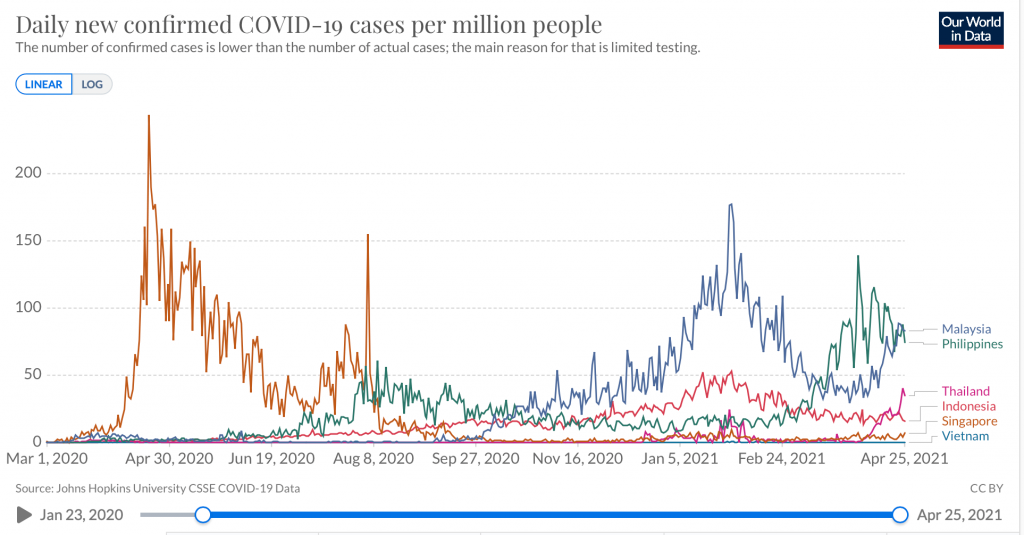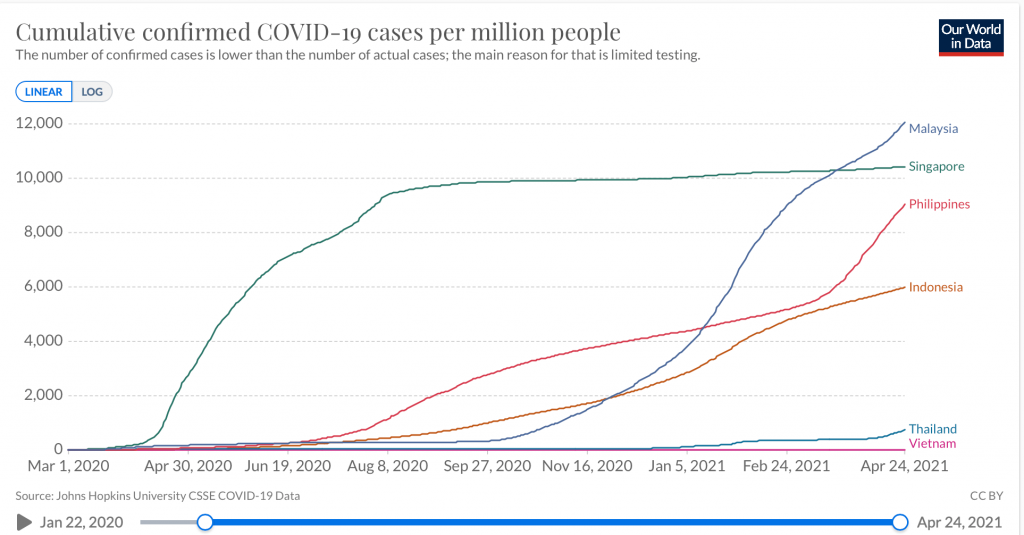KUALA LUMPUR, April 27 — Malaysia reported 282,708 new Covid-19 cases in less than four months this year, 2.5 times higher than the whole of 2020 since the virus hit the country.
Since the first Covid-19 case was reported in Malaysia on January 25 last year, Malaysia reported a cumulative of 395,718 Covid-19 cases as of yesterday.
Last year, within about 11 months, the nation reported 113,010 positive Covid-19 cases until December 31, but this year, in just four months until April 26, Malaysia recorded 282,708 infections.
Although authorities have denied that the country is currently in the fourth wave of the epidemic, the trend of new Covid-19 cases over the past three weeks has been rising.
Public health expert and epidemiologist from University Malaya Dr Sanjay Rampal told CodeBlue that it doesn’t matter if the latest increase in outbreaks is termed as the third or fourth wave as they are only semantics, but said Malaysia is seeing the development of large outbreaks and higher incidences in specific states.
“It’s clear that there was a sharp rise in transmission earlier in the month that has slowed down at the national level,” Dr Sanjay said.
“However, at the state level, Selangor, Kuala Lumpur, Kelantan, and Sarawak had reported 14-day incidence density exceeding 100 cases per 100,000 population. Kelantan has had the highest increase in transmission with an Rt of two last week.”
An Rt, or reproductive rate, of 2.0 means that each Covid-19 case on average leads to another two cases.
Dr Sanjay urged the government to permanently increase public health capacity in terms of contact tracing and outbreak teams to handle the epidemic.
Over the past month, Malaysia’s new Covid-19 cases have been increasing consistently from 1,247 average daily cases in the week of March 23 to March 29 — the lowest since the late January peak of 4,618 average daily infections — to 2,655 average daily cases in the past week of April 20 to 26.
If the average number of daily new Covid-19 cases is maintained this week, Malaysia will surpass the 400,000 cumulative mark within the next two days.
Between January 5 and January 11, before the government imposed the second Movement Control Order (MCO), the average daily number of new Covid-19 cases was 2,487 — higher than the current average daily 2,655 new cases.
The second MCO lasted seven weeks from January 13 till March 4, which was then replaced with a Conditional Movement Control Order (CMCO).
During the second MCO, the nation’s average daily Covid-19 cases peaked between January 26 and February 1 at 4,618 cases a day, before dropping to an average of 1,773 daily cases between March 2 and March 8, a decline of 61.6 per cent.
After the second MCO was lifted, the nation’s daily Covid-19 cases continued reducing gradually until March 29, with the trend of decline post-lockdown only lasting for three weeks.
Although the number of coronavirus cases has been gradually increasing since April, the government is still maintaining the containment approach, such as implementing targeted movement control orders in managing the epidemic, rather than using the mitigation approach which is to prevent severe Covid-19 and deaths.
The Health and Science Covid-19 Advisory Group of Experts (EAG) urged the government to use mitigation measures to prevent a fourth Covid-19 wave, such as by implementing targeted MCOs with a more comprehensive digital find, test, trace, isolation, and support (FTTIS) element.
Currently, most states, federal territories, and districts in Malaysia such as Penang, Selangor, Sarawak, and Kuala Lumpur are under the CMCO, while Kelantan is under the implementation of a statewide MCO.
However, in CMCO areas, with Hari Raya celebrations nearing, although inter-state travel is banned, other daily and social activities are allowed, including Ramadan bazaars that are allowed to operate until 2am everyday, 100 per cent capacity to work in office, shops are allowed to operate until 12am, etc.
With two and half weeks close to Hari Raya, the government has yet to announce the standard operating procedures (SOPs) for this year’s Eid celebrations.
Last year, although during the Hari Raya season at the end of May, the nation was only reporting two-digit daily Covid-19 cases, the SOP set for Hari Raya was strict. For example, visiting was only allowed on the first day of Hari Raya, no inter-state travel or Ramadan bazaars were allowed, and a maximum of 20 people were permitted in a house at the same time.
In other countries, like Singapore, although their daily Covid-19 cases have been less than 50 cases per day, their easing of restrictions has been more gradual. For instance, 75 per cent of employees can work at the office at a time, social gatherings at restaurants are restricted to eight people etc.
Malaysia has been reporting over 2,000 daily new coronavirus cases for 12 days consecutively since April 15 now.

According to Our World In Data, from March 14 until April 24 this year, daily new Covid-19 cases per 1,000,000 population in Malaysia was the second highest in the region after the Philippines, followed by Thailand, Indonesia, Singapore, and Vietnam.
However, on April 25, Malaysia surpassed the Philippines with 83.1 new Covid-19 cases per 1,000,000 population, as the Philippines reported 74.31 cases per 1,000,000 population. This was followed by Thailand (34.93), Indonesia (16.09), Singapore (6.84), and Vietnam (0.10).

Meanwhile, cumulative Covid-19 cases per 1,000,000 population was highest in Malaysia as of April 23 at 11,974, followed by Singapore (10,417), Philippines (8,941), Indonesia (5,967), Thailand (719), and Vietnam (29).
It is important to note that countries like the Philippines and Indonesia have been underreporting their Covid-19 cases, according to media reports.
Overall, the Philippines, with a population of 108.1 million people, has registered 979,740 positive cases as of April 23, while Indonesia with a population of 270.6 million people has a cumulative number of 1.63 million Covid-19 cases.
Malaysia, with a population of 32.7 million people, registered the third highest cumulative number of Covid-19 infections in ASEAN as of April 24 at 387,535 cases.








